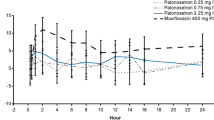Abstract
The aim of the work was to evaluate the impact of cyclophosphamide and ondansetron on serotonin metabolism measured by urinary 5-hydroxyindoleacetic acid (5-HIAA) excretion. The pattern of urinary 5-HIAA excretion was analysed within 24 h following cyclophosphamide, epirubicin and 5-fluorouracil (FEC) chemotherapy (n =14), ondansetron as single agent (n=31), and in a control group (n=62). 5-HIAA was measured by a fluorescence/polarisation immunoassay. Both FEC and ondansetron alone induced a significantly higher 5-HIAA increase following the first 12 h after drug administration when compared to the control group. The comparison of quantitative variables of 5-HIAA excretion between FEC and ondansetron failed to reveal any statistical differences. Cyclophosphamide-based chemotherapy is associated with only minor increases of 5-HIAA excretion. Analysis of 5-HIAA excretion does not help in the description of the pathophysiology of cyclophosphamide-induced emesis. In contrast to experimental data, serotonin 3 receptor antagonism with ondansetron induces an increase of 5-HIAA excretion in humans.
Similar content being viewed by others
References
Beck TM, Ciociola AA, Jones SE, et al (1993) Efficacy of oral ondansetron in the prevention of emesis in outpatients receiving cyclophosphamidebased chemotherapy. Ann Intern Med 118:407–413
Bonneterre J, Chevallier B, Metz R, et al (1990) A randomized doubleblind comparison of ondansetron and metoclopramid in the prophylaxis of emesis induced by cyclophosphamide, fluorouracil and doxorubicin or epirubicin chemotherapy. J Clin Oncol 8:1063–1069
Bountra C, Bunce K, Dale T, et al (1993) Anti-emetic profile of a nonpeptide neurokinin NK1 receptor antagonist, CP 99,994, in ferrets. Eur J Pharmacol 249:R3-R4
Brasheer J, Zeitvogel C, Jackson J, et al (1989) Fluorescence polarisation immunoassay of urinary 5-hydroxy-3indoleacetic acid. Clin Chem 35:355–359
Buser KS, Joss RA, Piquet D, et al (1993) Oral ondansetron in the prophylaxis of nausea and vomiting induced by cyclophosphamide, methotrexate and 5-fluorouracil (CMF) in women with breast cancer. Results of a prospective, randomized, doubleblind, placebo-controlled study. Ann Oncol 4:475–479
Cubeddu LX, Hoffmann IS (1993) Participation of serotonin on early and delayed emesis induced by initial and subsequent cycles of cisplatinumbased chemotherapy: effects of antiemetics. J Clin Pharmacol 33:691–697
Cubeddu LX, Hoffman IS, Fuenmayor NT, Finn AL (1990) Efficacy of ondansetron (GR 32038F) and the role of serotonin in cisplatin induced nausea and vomiting. N Engl J Med 322:810–816
Cubeddu LX, Hoffmann IS, Fuenmayor NT, Malave JJ (1992) Changes in serotonin metabolism in cancer patients: its relationship to nausea and vomiting induced by chemotherapeutic drugs. Br J Cancer 66:198–203
Cubeddu LX, Pendergrass K, Ryan T, et al (1994) Efficacy of oral ondansetron, a selective antagonist of 5HT3 receptors, in the treatment of nausea and vomiting associated with cyclophosphamide-based chemotherapies. Am J Clin Oncol 17:137–146
Cubeddu LX, O'Connor DT, Hoffmann IS, Partner RJ (1995) Plasma chromogranin A marks emesis and serotonin release associated with da carbazine and nitrogen mustard but not with cyclophosphamide based chemotherapies. Br J Cancer 72:1033–1038
Du Bois A, Siebert C, Kriesinger-Schroeder H (1995) Cisplatin-induced alterations of serotonin metabolism in patients with and without emesis. Oncol Rep 2:839–842
Du Bois A, Siebert C, Schäfer C, Kriesinger-Schroeder H, Meerpohl HG (1995) The role of serotonin as a mediator of emesis induced by different stimuli. Support Care Cancer 3:285–290
Du Bois A, Cramer-Giraud U, Kiechle-Schwarz M, Vach W, Meerpohl HG (1996) Pathophysiology, severity, pattern, and risk-factors for carboplatin-induced emesis. Oncology (in press)
Gebauer A, Merger M, Kilbinger H (1993) Modulation by 5-HT3 and 5HT4 receptors of the release of 5-hydroxytryptamine from the guinea-pig small intestine. Naunyn Schmiedeberg's Arch Pharmacol 347:137–140
15.Italian Group for Antiemetic Research (1995) Dexamethasone, granisetron, or both for the prevention of nausea and vomiting during chemotherapy for cancer. N Engl J Med 332:1–5
Martin Jimenez M, Diaz-Rubio E, Blazquez Encinar JC, et al (1988) Tolerancia, toxicidad y aceptacion del tratamiento quimioterapico FAC (5-fluorouracilo, adrimicina y ciclofasfamida) en et cancer de mama. Analisis de 100 pacientes consecutivas. Neoplasia 5:8–14
Minami M, Tamakai H, Ogawa T, et al (1995) Chemical modulation of 5HT3 and 5-HT4 receptors affects the release of 5-hydroxytryptamine from the ferret and rat intestine. Res Commun Mol Pathol Pharmacol 89:131–142
Miner WD, Sanger GJ, Turner DH (1987) Evidence that 5-hydroxytryptamine3 receptors mediate cytotoxic drug and radiation-evoked emesis. Br J Cancer 56:159–162
Schwoerer H, Racke K, Kilbinger H (1991) Cisplatin increases the release of 5-hydroxytryptamine (5-HT) from the isolated vasculary perfused small intestine of the guinea pig: involve ment of the 5-HT3 receptors. Naunyn Schmiedeberg's Arch Pharmacol 344:143–149
Author information
Authors and Affiliations
Rights and permissions
About this article
Cite this article
du Bois, A., Vach, W., Holy, R. et al. 5-Hydroxyindoleacetic acid excretion following combination chemotherapy with cyclophosphamide, epirubicin and 5-fluorouracil plus ondansetron compared to ondansetron alone. Support Care Cancer 4, 384–389 (1996). https://doi.org/10.1007/BF01788846
Issue Date:
DOI: https://doi.org/10.1007/BF01788846




